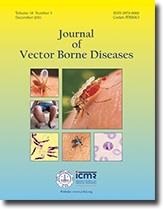Ver ítem
- xmlui.general.dspace_homeCentros Regionales y EEAsCentro Regional Santa FeEEA RafaelaArtículos científicosxmlui.ArtifactBrowser.ItemViewer.trail
- Inicio
- Centros Regionales y EEAs
- Centro Regional Santa Fe
- EEA Rafaela
- Artículos científicos
- Ver ítem
Babesiosis prevalence in malaria-endemic regions of Colombia
Resumen
Background & objectives: The presence of Babesia spp in humans, bovine cattle and ticks (the transmitting vector) has not been well characterized in Colombia. Babesia infection in humans can be overlooked due to similarity of the disease symptoms with malaria specially in the regions where malaria is endemic. The aim of the present work was to study the frequency of Babesia infection in humans, bovines and ticks in a malaria endemic region of Colombia,
[ver mas...]
Background & objectives: The presence of Babesia spp in humans, bovine cattle and ticks (the transmitting vector) has not been well characterized in Colombia. Babesia infection in humans can be overlooked due to similarity of the disease symptoms with malaria specially in the regions where malaria is endemic. The aim of the present work was to study the frequency of Babesia infection in humans, bovines and ticks in a malaria endemic region of Colombia, and explore the possible relationship of infection with host and the environmental factors. Methods: A cross-sectional study was carried out between August 2014 and March 2015 to determine the frequency of B. bovis and B. bigemina infection in a sample of 300 humans involved in cattle raising, in 202 bovines; and in 515 ticks obtained from these subjects, using molecular (PCR), microscopic and serological methods. In addition, the demographic, ecological and zootechnical factors associated with the presence of Babesia, were explored. Results: In the bovine population, the prevalence of infection was 14.4% (29/202); the highest risk of infection was found in cattle under nine months of age (OR = 23.9, CI 8.10–94.30, p = 0.0). In humans, a prevalence of 2% (6/300) was found; four of these six cases were positive for B. bovis. Self-report of fever in the last seven days in the positive cases was found to be associated with Babesia infection (Incidence rate ratio = 9.08; CI 1.34–61.10, p = 0.02). The frequency of B. bigemina infection in the collected ticks was 18.5% (30/162). Interpretation & conclusion: The study established the presence of Babesia spp in humans, bovines and ticks. The most prevalent species responsible for babesiosis in humans and bovines was B. bovis, while B. bigemina was the species most frequently found in the tick population. The results contribute to the knowledge of the epidemiology of babesiosis in the country and can provide guidelines for the epidemiological surveillance of this non-malarial febrile illness in humans as well as cattle.
[Cerrar]

Autor
González Obando, Juliana;
Echaide, Ignacio Eduardo;
Pabón Vidal, Adriana Lucía;
Piñeros Jiménez, Juan Gabriel;
Blair Trujillo, Silvia;
Tobón Castaño, Alberto;
Fuente
Journal of Vector Borne Diseases 55 (3) : 222-229. (Jul.-Sep. 2018)
Fecha
2018-07
Editorial
Wolters Kluwer
ISSN
0972-9062
Formato
pdf
Tipo de documento
artículo
Palabras Claves
Derechos de acceso
Abierto
 Excepto donde se diga explicitamente, este item se publica bajo la siguiente descripción: Creative Commons Attribution-NonCommercial-ShareAlike 2.5 Unported (CC BY-NC-SA 2.5)
Excepto donde se diga explicitamente, este item se publica bajo la siguiente descripción: Creative Commons Attribution-NonCommercial-ShareAlike 2.5 Unported (CC BY-NC-SA 2.5)


